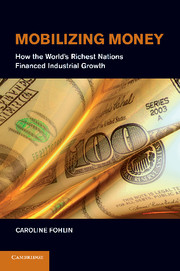Book contents
9 - What Is Important for Long-Term Growth?
Published online by Cambridge University Press: 05 January 2012
Summary
This book has brought together a wide array of evidence – from the level of individual firms to the broadest possible international comparison – to offer a new synthesis of financial system design and industrial development. What causes financial systems to develop as they do, and how does the pattern of financial development influence real economic outcomes? Both parts of the book shed new light on these questions.
By taking a close look at the emergence of corporate finance systems in five economies, the first set of chapters provides new insights into the details of financial systems. Each of the countries examined in these chapters began the process of large-scale industrialization at some point in the nineteenth century – early on in the case of the United Kingdom, mid- century for Germany and the United States, and toward the end for Italy and Japan. The microeconomic view that predominates in these four chapters permits a fine-grained portrait of the range of political, economic, legal, and even cultural factors that have played into these five financial systems.
- Type
- Chapter
- Information
- Mobilizing MoneyHow the World's Richest Nations Financed Industrial Growth, pp. 222 - 230Publisher: Cambridge University PressPrint publication year: 2011



